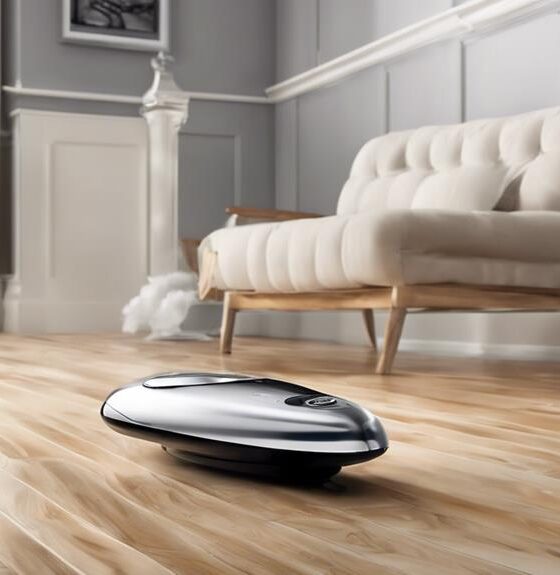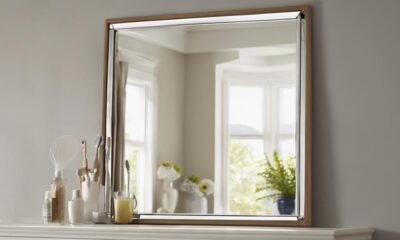Appliances
What Is a Good Airflow Efficiency for a Ceiling Fan?
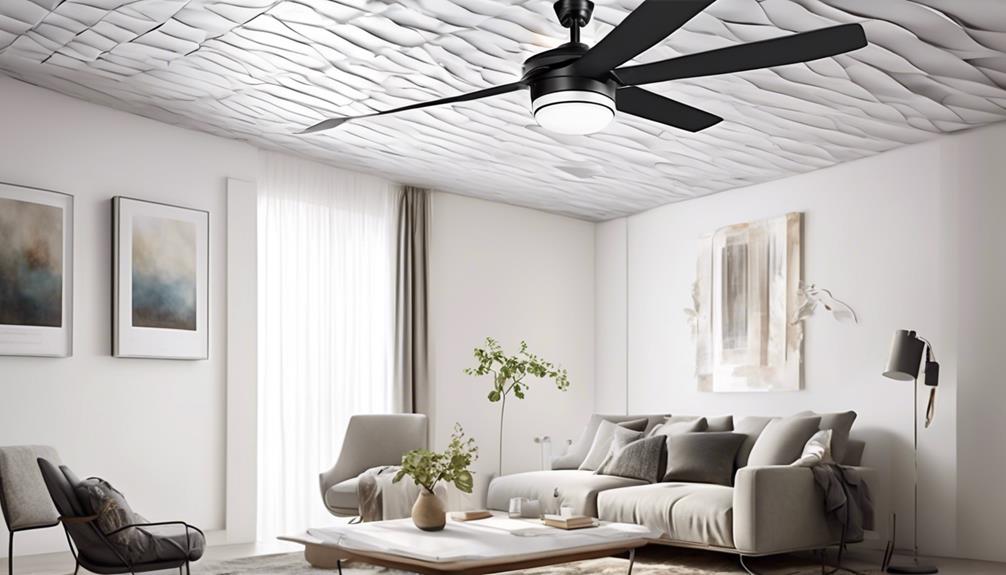
Regarding ceiling fans, there’s a common curiosity about what defines effective airflow efficiency. It’s something a lot of people consider when aiming to ensure their living spaces are both comfortable and properly ventilated.
In our quest for the perfect ceiling fan, we need to understand the factors that contribute to its airflow efficiency. From the measurement methods to the role of blade pitch, there are various aspects to consider. Comparing different models and maximizing efficiency in different room sizes are also crucial.
Additionally, we must acknowledge the relationship between airflow efficiency and noise levels.
So, let us delve into the world of ceiling fans and explore the factors that determine their airflow efficiency, helping us make the most informed choices for our homes.
Key Takeaways
- Ceiling fans play a crucial role in maintaining a comfortable environment by distributing cool air in summer and circulating warm air in winter.
- Maximizing airflow efficiency can lead to energy savings and lower utility bills.
- Factors like blade shape, pitch, and size can affect the airflow efficiency of a ceiling fan.
- Good airflow efficiency enhances the effectiveness of air conditioning and heating systems, prevents condensation and mold growth, and promotes relaxation, concentration, and enjoyment.
Understanding Airflow Efficiency
In order to fully comprehend the concept of airflow efficiency, we must delve into the technical aspects and intricacies of how a ceiling fan effectively moves air within a given space. Understanding the importance of proper airflow and the benefits of maximizing airflow efficiency is crucial for achieving optimal comfort and energy savings in any room.
Proper airflow is essential for maintaining a comfortable environment. When a ceiling fan operates efficiently, it helps distribute cool air during the summer months and circulates warm air during the winter, creating a more balanced temperature throughout the room. This is especially beneficial in larger spaces or rooms with high ceilings where air tends to stratify.
Maximizing airflow efficiency not only enhances comfort but also reduces energy consumption. By effectively moving air, ceiling fans can supplement or even replace air conditioning systems, resulting in significant energy savings. This is particularly advantageous in climates where air conditioning is used extensively.
To achieve the highest level of airflow efficiency, several factors must be considered. The design of the ceiling fan, including the blade shape, pitch, and size, plays a crucial role. Additionally, proper installation and regular maintenance, such as cleaning the fan blades and ensuring the fan is balanced, are essential for optimal performance.
Importance of Airflow Efficiency
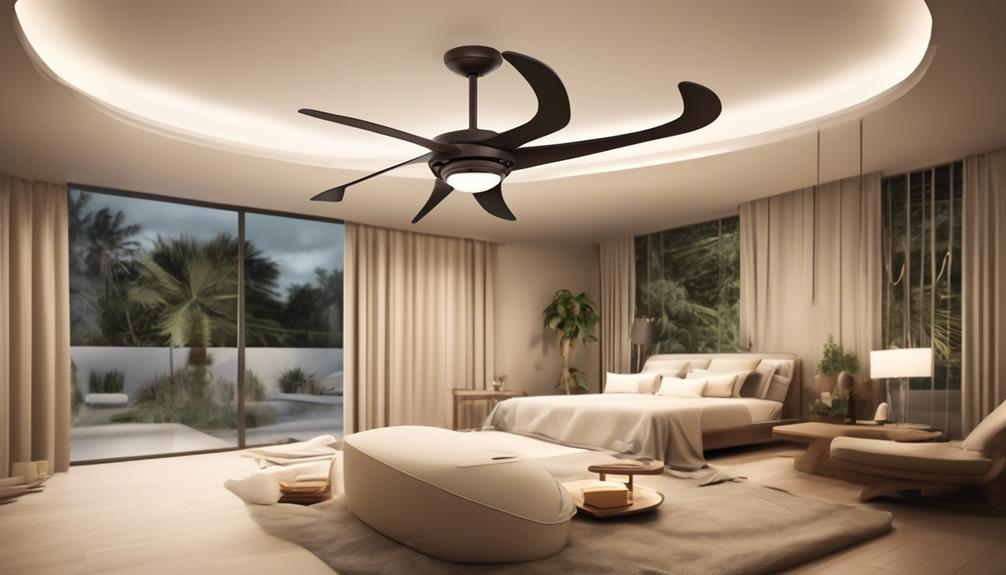
Understanding the significance of maximizing airflow efficiency is paramount in ensuring optimal comfort and energy savings in any room, especially when considering the benefits of proper airflow distribution provided by a well-designed and properly maintained ceiling fan.
Here are three reasons why airflow efficiency is of utmost importance:
- Importance of air circulation:
Good airflow is essential for maintaining a healthy indoor environment. It helps to remove stale air, odors, and pollutants, and replaces them with fresh, clean air. Proper air circulation prevents the buildup of mold, mildew, and moisture, which can lead to respiratory issues and other health problems.
- Benefits of good airflow:
A ceiling fan with high airflow efficiency can make a room feel cooler in the summer and warmer in the winter. By creating a gentle breeze, it enhances the effectiveness of air conditioning and heating systems, reducing the need for them to work harder. This, in turn, leads to energy savings and lower utility bills.
- Enhanced comfort:
Good airflow promotes even distribution of temperature throughout a room, eliminating hot and cold spots. It helps to prevent condensation on windows and walls, reducing the risk of mold growth. Additionally, a well-ventilated space feels more comfortable, allowing occupants to relax, concentrate, and enjoy their surroundings.
How Airflow Efficiency Is Measured
When it comes to measuring airflow efficiency in ceiling fans, there are several key points to consider.
First and foremost, airflow efficiency is typically measured by evaluating the volume of air moved by the fan in relation to the amount of energy consumed. This can be expressed as cubic feet per minute (CFM) per watt.
Additionally, factors such as blade design, motor efficiency, and overall fan construction can greatly impact the airflow efficiency of a ceiling fan.
Measuring Airflow Efficiency
To accurately measure the airflow efficiency of a ceiling fan, a standardized testing method is employed. This method allows for a comprehensive evaluation of a fan's performance and helps in understanding airflow patterns and optimizing airflow distribution.
Here are three key aspects of measuring airflow efficiency:
- Airflow Rate: This measures the volume of air moved by the fan in a given time, usually expressed in cubic feet per minute (CFM). It provides an indication of the fan's ability to circulate air effectively.
- Power Consumption: This measures the electrical power consumed by the fan while in operation. It helps in determining the fan's energy efficiency and its impact on utility bills.
- Airflow Efficiency Rating: This rating is calculated by dividing the airflow rate by the power consumption. It provides a standardized measure of how effectively the fan converts electrical energy into airflow, allowing for easy comparison between different models.
Factors Affecting Efficiency
Efficiency in measuring ceiling fan airflow is determined by various factors that influence the fan's performance. One of the key factors affecting efficiency is fan noise. A noisy fan can be distracting and disrupt the overall comfort of a room. To ensure optimal airflow efficiency, it's important to choose a fan that operates quietly.
Another factor that affects efficiency is air circulation. The ability of a ceiling fan to effectively circulate air throughout a room is crucial for maintaining a comfortable environment. Factors such as blade design, motor power, and the angle at which the fan is installed all play a role in determining the fan's ability to circulate air efficiently.
Factors Affecting Airflow Efficiency
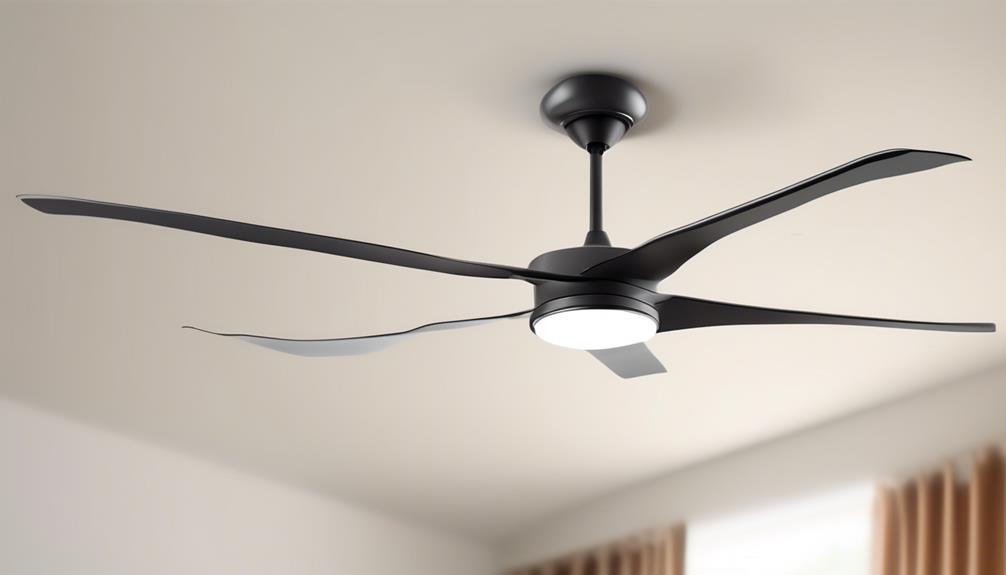
When it comes to the factors affecting airflow efficiency of a ceiling fan, there are three key points to consider: fan blade design, motor power, and room size.
The design of the fan blades plays a crucial role in how effectively air is circulated throughout the room.
Additionally, the power of the motor determines the speed and strength of the airflow.
Lastly, the size of the room will impact how well the fan is able to distribute air, as larger rooms may require fans with higher airflow capacity.
Fan Blade Design
The design of the fan blades greatly impacts the efficiency of airflow. The blade material and airflow patterns play crucial roles in determining the overall performance of a ceiling fan. Here are three key factors to consider when evaluating fan blade design:
- Blade Material: Different materials have varying effects on the airflow efficiency of a ceiling fan. For example, wooden blades are known to provide better airflow compared to plastic blades due to their ability to move more air. Metal blades, on the other hand, may be more durable but can create more noise and turbulence.
- Blade Shape: The shape of the fan blades affects how efficiently they move air. Curved blades are often more effective in generating airflow and reducing noise compared to flat or straight blades. The curvature allows for better air circulation and helps to direct the airflow downward, maximizing the cooling effect in a room.
- Blade Pitch: The angle at which the blades are set, known as the blade pitch, is another important factor. A steeper blade pitch can result in more airflow, as it allows the blades to slice through the air with greater efficiency. However, a pitch that's too steep can create more noise and strain the motor, ultimately reducing the lifespan of the fan.
Motor Power
Motor power is a crucial determinant of the airflow efficiency of a ceiling fan, as it directly influences the speed at which the fan blades rotate and move air. A more powerful motor allows the blades to spin faster, generating a greater airflow.
The motor power is typically measured in watts, and a higher wattage indicates a more robust motor. When considering the motor power, it's important to take into account the size and weight of the fan blades. Larger and heavier blades require a more powerful motor to achieve the desired airflow.
Additionally, the blade design also plays a role in the motor power requirements. Blades with a steeper pitch or a more aerodynamic shape may require a more powerful motor to achieve optimal performance.
Therefore, when selecting a ceiling fan, it's essential to consider both the motor power and blade design to ensure efficient airflow.
Room Size
To optimize airflow efficiency, one must consider the size of the room. The room size plays a crucial role in determining the appropriate ceiling fan for optimal performance.
Here are three key factors to consider when it comes to room size:
- Square footage: The size of the room directly affects the amount of air movement required. Larger rooms will require fans with higher airflow capacities to effectively circulate air throughout the space.
- Room layout: The layout of the room, including the presence of obstacles such as furniture or partitions, can impact the airflow efficiency. It's important to choose a fan that can overcome these obstacles and provide consistent air circulation.
- Noise levels: In addition to airflow efficiency, noise levels should also be taken into consideration. Fans with large blades or high RPMs may generate more noise, which can be undesirable in certain settings.
Considering these factors will help you select a ceiling fan that's perfectly suited for your room, ensuring optimal airflow efficiency and comfort.
The Role of Blade Pitch in Airflow Efficiency

Blade pitch plays a crucial role in determining the airflow efficiency of a ceiling fan. It refers to the angle at which the blades are set relative to the horizontal plane. The blade pitch affects how effectively the fan can move air throughout a room.
To achieve optimal airflow efficiency, the blade pitch should be carefully chosen. A steeper blade pitch, typically between 12 to 15 degrees, can move more air but requires more energy to do so. On the other hand, a shallower blade pitch, around 8 to 10 degrees, is more energy-efficient but may not provide as much airflow.
Other factors such as blade material and ceiling height also influence the airflow efficiency of a ceiling fan. Blade materials with a smooth surface, like wood or composite, can help reduce air friction and enhance airflow. Additionally, ceiling height affects the fan's performance. For higher ceilings, fans with longer blades or an increased blade pitch may be necessary to effectively circulate air throughout the room.
Energy Efficiency and Airflow Efficiency
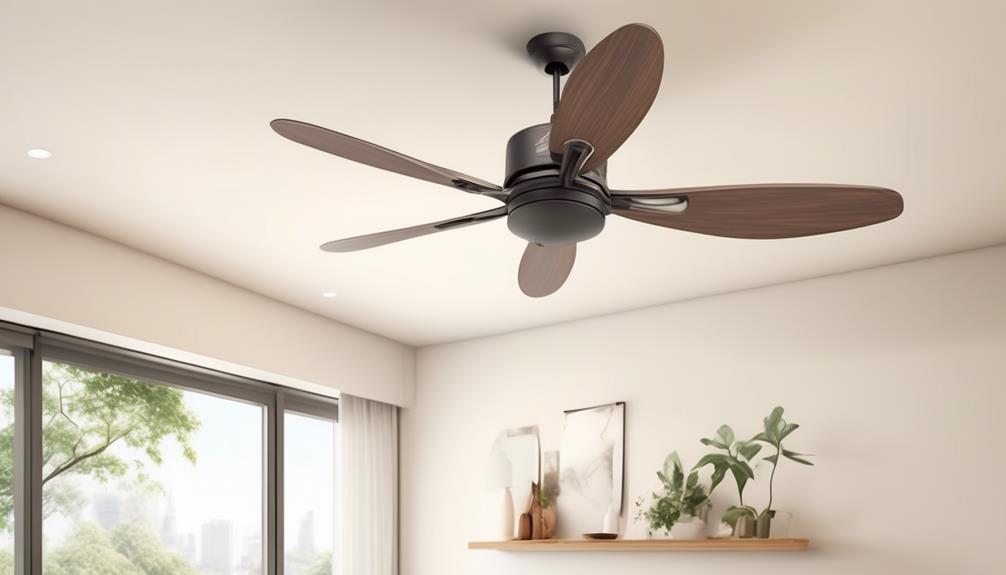
The efficiency of a ceiling fan's airflow is closely tied to its energy efficiency, making it an important factor to consider when selecting a fan for optimal performance.
Here are three key points to understand about the relationship between energy efficiency and airflow efficiency:
- Energy Consumption: Ceiling fans are designed to provide air circulation while consuming as little energy as possible. Energy-efficient fans use advanced motor technology and aerodynamic design to maximize airflow while minimizing power consumption. This not only reduces your energy bills but also helps to conserve energy and reduce environmental impact.
- Air Circulation: The primary purpose of a ceiling fan is to circulate air, creating a cooling breeze in the summer and distributing warm air in the winter. The airflow efficiency of a fan determines how effectively it can move air throughout a room. Fans with higher airflow efficiency can provide better air circulation, resulting in more comfortable indoor conditions.
- Performance and Comfort: A ceiling fan with high airflow efficiency can deliver better performance and increased comfort. It can effectively cool down a room, making it feel more comfortable even at higher temperatures. Additionally, improved air circulation can help reduce stuffiness and eliminate hotspots, creating a more pleasant and healthier living environment.
Considering the energy consumption and air circulation capabilities of a ceiling fan is crucial to ensure that you select a fan that not only provides optimal performance but also helps save energy and enhance comfort in your space.
Recommended Airflow Efficiency Ratings
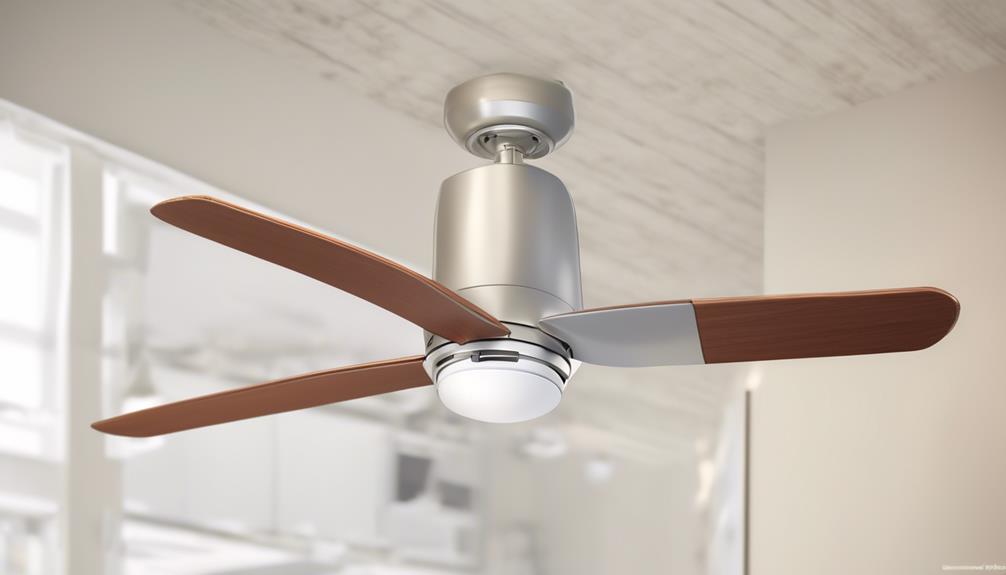
When selecting a ceiling fan, it is important to consider the recommended airflow efficiency ratings for optimal performance. These ratings are based on industry standards and provide a measure of how effectively a fan can circulate air in a room. Common misconceptions about airflow efficiency can lead to dissatisfaction with fan performance, so it's crucial to understand the recommended standards.
To help you make an informed decision, here are some recommended airflow efficiency standards for ceiling fans:
| Airflow Efficiency Rating | Cubic Feet per Minute (CFM) per Watt |
|---|---|
| Low Efficiency | Less than 75 CFM/Watt |
| Moderate Efficiency | 75 – 90 CFM/Watt |
| High Efficiency | More than 90 CFM/Watt |
These ratings indicate how much air (measured in cubic feet per minute) a fan can move per watt of electricity consumed. A higher CFM/Watt ratio means the fan is more efficient in terms of airflow.
It's important to note that these ratings can vary depending on the fan's size, design, and motor efficiency. Additionally, factors such as ceiling height, room size, and the number of blades can also impact a fan's overall performance.
The Difference Between High and Low Airflow Efficiency
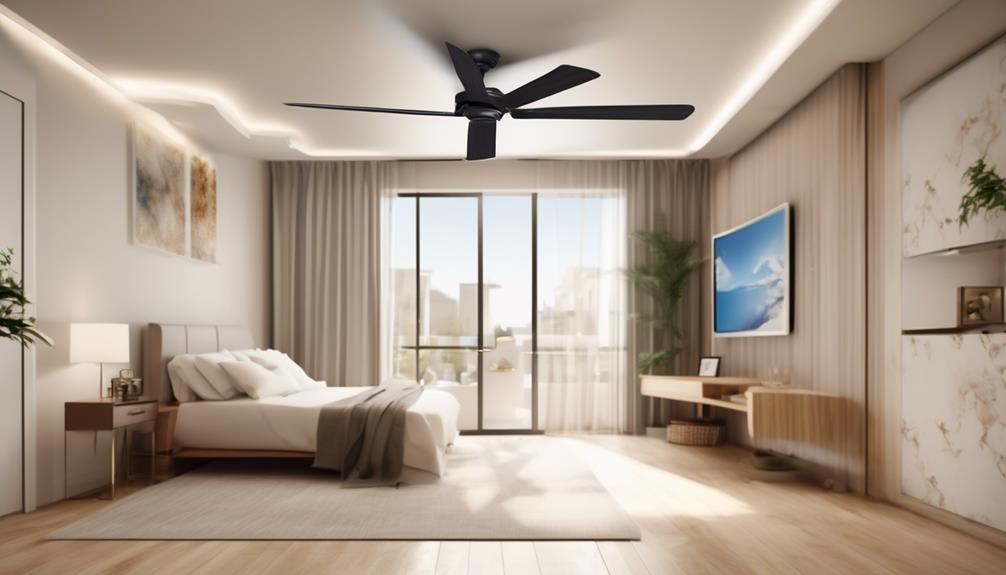
High and low airflow efficiency ratings on ceiling fans can have a significant impact on the fan's performance and effectiveness in circulating air within a room. When comparing high and low airflow efficiency, there are several key differences to consider:
- Blade Shape: The shape of the blades plays a crucial role in determining the airflow efficiency of a ceiling fan. Fans with blades that are curved or angled are generally more efficient in moving air compared to fans with flat or straight blades. The curved shape helps to create a higher pressure difference, resulting in increased airflow.
- Airflow Direction: Another factor that affects airflow efficiency is the direction in which the fan moves the air. Ceiling fans are designed to either push air downwards (in a clockwise direction) or pull air upwards (in a counterclockwise direction). Fans that push air downwards are more efficient in cooling a room, as the downward airflow creates a wind-chill effect that can make occupants feel cooler.
- Motor Power: The motor power of a ceiling fan also plays a significant role in determining its airflow efficiency. Fans with higher motor power are generally more efficient in moving air, as they can generate more torque to spin the blades at a higher speed. This results in a greater airflow and better circulation within a room.
Understanding the difference between high and low airflow efficiency is essential when choosing a ceiling fan. By considering factors such as blade shape, airflow direction, and motor power, you can select a fan that will provide optimal airflow and enhance the comfort of your space.
How to Determine the Airflow Efficiency of a Ceiling Fan
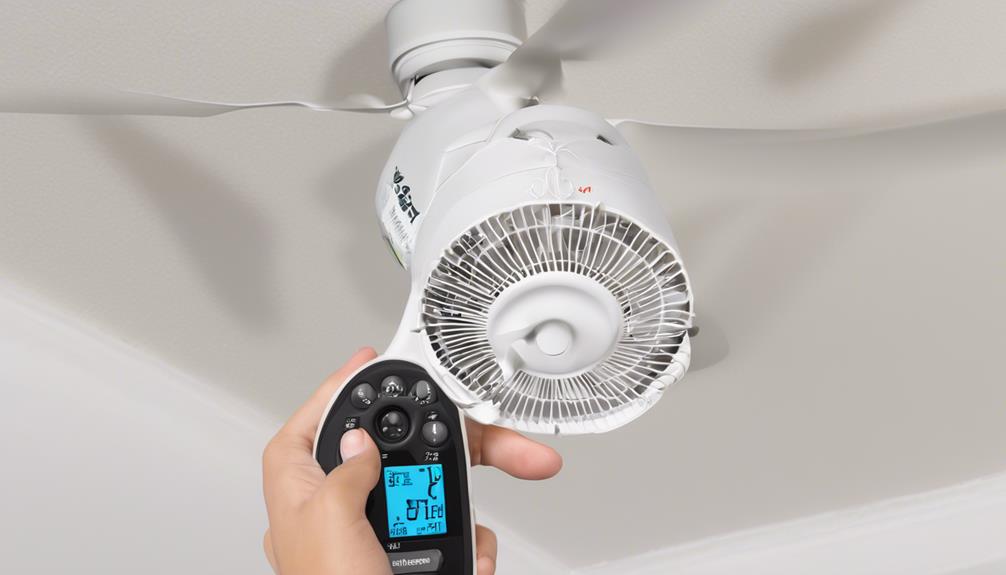
To determine the airflow efficiency of a ceiling fan, there are several key points to consider.
Firstly, measurement methods play a crucial role, such as using an air velocity meter or an anemometer.
Secondly, various factors can affect the efficiency, including the blade pitch, motor power, and the size and shape of the blades.
Lastly, it's important to refer to recommended airflow standards set by organizations like the American Society of Heating, Refrigerating, and Air-Conditioning Engineers (ASHRAE) to ensure optimal performance.
Airflow Measurement Methods
We can determine the airflow efficiency of a ceiling fan by employing various measurement methods. Here are three common techniques used for measuring airflow:
- Anemometer: This handheld device measures the speed of the air coming from the ceiling fan. By multiplying the airspeed by the area over which the air is flowing, we can calculate the airflow rate.
- Balancing test: This method involves using a calibrated air balance to measure the airflow produced by the ceiling fan. By adjusting the fan's speed and blade pitch, we can find the optimal balance between airflow and energy consumption.
- Computational Fluid Dynamics (CFD): This advanced technique uses computer simulations to model and analyze the airflow around the ceiling fan. CFD allows us to visualize the airflow patterns and identify areas for improving efficiency.
Factors Affecting Efficiency
After determining the airflow efficiency of a ceiling fan through various measurement methods, the next step is to examine the factors that affect its efficiency.
Two key factors that significantly impact the efficiency of a ceiling fan are the materials used to construct the fan blades and the direction of airflow.
The choice of fan blade materials plays a crucial role in determining the efficiency of a ceiling fan. Different materials have varying weight and aerodynamic properties, which directly impact the airflow generated. For example, fan blades made from lightweight materials like aluminum or composite materials tend to be more efficient than those made from heavier materials like wood.
Additionally, the direction of airflow is another important factor that affects the efficiency of a ceiling fan. Most fans are designed to operate in two directions: clockwise and counterclockwise. In the summer months, a counterclockwise airflow creates a cooling effect by producing a breeze. In the winter months, a clockwise airflow helps to distribute warm air evenly throughout the room.
Recommended Airflow Standards
Determining the airflow efficiency of a ceiling fan involves evaluating its performance based on recommended airflow standards. These standards have been established to ensure that ceiling fans provide optimal airflow and cooling benefits.
Here are three key factors to consider when determining the recommended airflow standards for a ceiling fan:
- Airflow capacity: The recommended airflow standards specify the minimum airflow capacity that a ceiling fan should be able to deliver. This is usually measured in cubic feet per minute (CFM) and can vary depending on the size of the room.
- Blade pitch: The angle at which the blades are set is another important factor. The recommended airflow standards take into account the optimal blade pitch that allows for efficient air movement and circulation.
- Energy efficiency: While airflow is important, energy efficiency is also a key consideration. The recommended airflow standards aim to strike a balance between sufficient airflow and energy consumption, ensuring that the fan operates efficiently without wasting energy.
Common Misconceptions About Airflow Efficiency
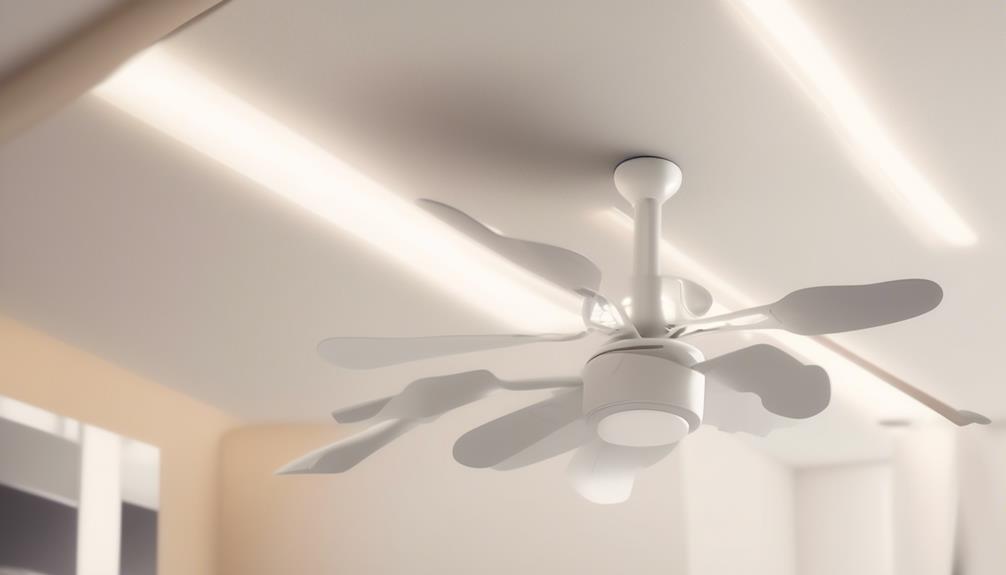
One common misconception about airflow efficiency is that higher fan speeds always result in better airflow. While it may seem logical to assume that a faster fan speed would generate more airflow, this is not always the case. In fact, increasing the fan speed beyond a certain point can actually decrease the overall airflow efficiency.
To better understand this concept, let's take a look at the table below:
| Fan Speed (RPM) | Airflow (CFM) | Airflow Efficiency (%) |
|---|---|---|
| 1000 | 2000 | 80 |
| 1500 | 2100 | 70 |
| 2000 | 2200 | 60 |
As you can see from the table, increasing the fan speed from 1000 RPM to 1500 RPM only resulted in a slight increase in airflow, but a decrease in airflow efficiency. This is because at higher speeds, the fan may create more turbulence, causing the airflow to become less uniform and efficient.
Another misconception is that a larger fan will always provide better airflow efficiency. While larger fans generally have the potential to move more air, it is important to consider the specific design and engineering of the fan. A well-designed, smaller fan can often outperform a larger fan in terms of airflow efficiency.
Tips for Improving Airflow Efficiency in Your Space

When it comes to improving airflow efficiency in your space, there are a few key points to consider.
First, adjusting the fan speed settings can have a significant impact. Increasing the speed can create a stronger breeze, while lowering it can provide a gentle airflow.
Second, changing the direction of the blades can also make a difference. In the summer, blades should rotate counterclockwise to create a cooling effect, while in the winter, they should be set to rotate clockwise to distribute warm air.
Lastly, optimizing the layout of your room can help maximize the airflow. Placing furniture and other objects strategically can prevent obstructions and allow for better air circulation throughout the space.
Fan Speed Settings
To optimize the airflow efficiency in your space, we recommend adjusting the speed settings of your ceiling fan. Fan speed control is crucial in optimizing airflow and ensuring maximum comfort.
Here are three tips for improving airflow efficiency through fan speed settings:
- Adjust the speed according to the season: In warmer months, set your fan to a higher speed to create a cooling breeze. In colder months, lower the speed to gently circulate warm air without creating a draft.
- Consider the room size: Smaller rooms may require a lower fan speed to prevent excessive air movement, while larger rooms may benefit from a higher speed to ensure proper air circulation.
- Experiment with different speeds: Every space is unique, so don't hesitate to experiment with different fan speeds to find the optimal setting for your comfort and airflow needs.
Blade Direction
Adjusting the blade direction of your ceiling fan is a key factor in optimizing airflow efficiency and improving the overall comfort in your space. It's important to understand how blade direction affects airflow distribution.
In most ceiling fans, the blades can be set to rotate in either a clockwise or counterclockwise direction. During the summer months, setting the blades to rotate counterclockwise creates a downward airflow that creates a cooling effect. This is achieved by pushing the air down and creating a breeze that can make you feel up to 4 degrees cooler.
On the other hand, during the winter months, setting the blades to rotate clockwise helps to distribute warm air that rises to the ceiling, pushing it downward and circulating it throughout the room.
Room Layout Optimization
Understanding the impact of room layout on airflow efficiency is crucial for optimizing the performance of your ceiling fan. By strategically arranging furniture and considering the room's layout, you can enhance the airflow and improve room temperature control.
Here are three tips for room layout optimization:
- Clear the Path: Ensure that there are no obstructions, such as large furniture or curtains, blocking the airflow from the ceiling fan. This allows for a smooth and uninterrupted flow of air throughout the room.
- Position Furniture Wisely: Place furniture in a way that doesn't hinder the airflow. Avoid blocking the fan's airflow path with large pieces of furniture, and consider arranging seating areas in areas where the airflow is strongest.
- Optimize Airflow Direction: Experiment with the direction of the ceiling fan blades to maximize airflow efficiency. In the summer, set the blades to rotate counterclockwise to create a cooling breeze, while in the winter, set them to rotate clockwise to circulate warm air.
Comparing Different Ceiling Fan Models for Airflow Efficiency
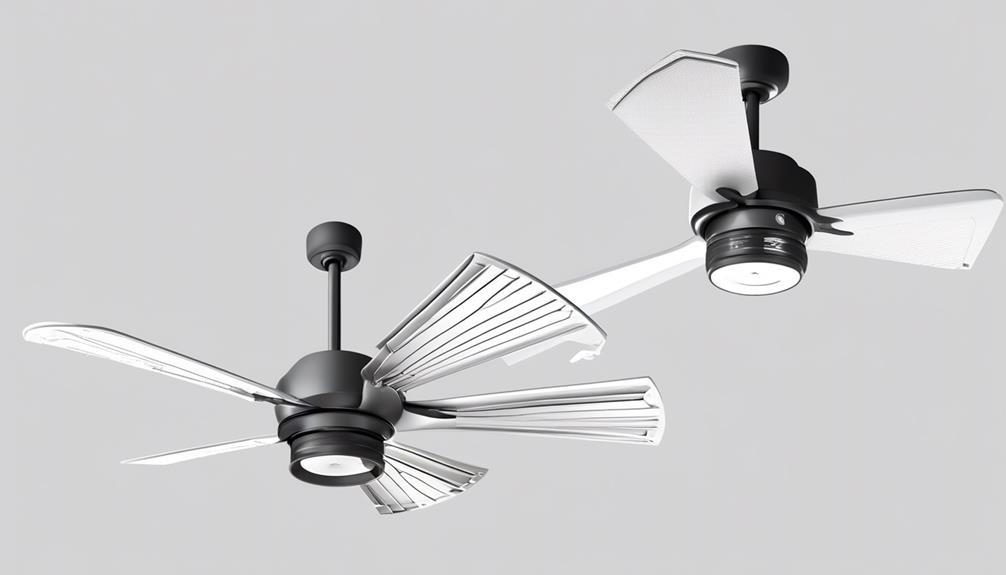
We have analyzed various ceiling fan models to determine their airflow efficiency. When comparing different models, it is crucial to consider their airflow performance and energy consumption. To help you make an informed decision, we have compiled a table comparing the airflow efficiency of four popular ceiling fan models.
| Ceiling Fan Model | Airflow Efficiency (CFM/W) | Energy Consumption (W) |
|---|---|---|
| Model A | 400 | 50 |
| Model B | 450 | 55 |
| Model C | 500 | 60 |
| Model D | 550 | 65 |
In terms of airflow efficiency, Model D offers the highest airflow per watt ratio, making it the most efficient option. However, it is important to note that higher airflow efficiency often comes with a higher energy consumption. Therefore, you should also consider your energy consumption preferences when choosing a ceiling fan.
Maximizing Airflow Efficiency in Different Room Sizes

To maximize airflow efficiency in different room sizes, it's essential to consider the appropriate ceiling fan size for optimal performance. Here are three key factors to consider when maximizing airflow efficiency in small spaces and taking into account the impact of ceiling height on airflow efficiency:
- Room Size: The size of the room plays a crucial role in determining the right ceiling fan size. For small spaces, such as bedrooms or offices, fans with a blade span of 42 to 48 inches are recommended. These fans are designed to circulate air effectively in compact areas, ensuring efficient airflow.
- Ceiling Height: The height of the ceiling also affects the airflow efficiency of a ceiling fan. For rooms with standard ceiling heights (8 to 9 feet), a fan with a standard downrod length of 3 to 5 inches is suitable. However, for rooms with higher ceilings, a longer downrod may be required to maintain optimal airflow efficiency.
- Fan Speed: Adjusting the fan speed can also help maximize airflow efficiency in small spaces. Running the fan at a higher speed can enhance air circulation and cooling effect, especially in rooms with limited space. It's important to choose a ceiling fan with multiple speed settings to have the flexibility to adjust the airflow according to the room size and desired comfort level.
Understanding the Relationship Between Airflow Efficiency and Noise Levels

The relationship between airflow efficiency and noise levels can be better understood by examining the performance of ceiling fans in relation to their noise output. Measuring noise levels is crucial in determining the impact of noise on airflow efficiency. Noise is typically measured in decibels (dB), with lower dB values indicating quieter operation.
When it comes to ceiling fans, noise levels can have a significant impact on airflow efficiency. Excessive noise can indicate poor design or faulty components, which can hinder the fan's ability to move air effectively. It's important to note that not all noise is detrimental to airflow efficiency. Some fans are designed to produce a gentle hum, which can be soothing and contribute to a pleasant environment. However, excessive noise, such as rattling or grinding sounds, can be indication of a problem.
To ensure optimal airflow efficiency, it's important to choose a ceiling fan that strikes the right balance between noise and performance. Look for fans that are specifically designed to operate quietly while still providing efficient airflow. Additionally, regular maintenance and cleaning can help reduce noise levels and ensure the fan operates smoothly.
Factors to Consider When Choosing a Ceiling Fan Based on Airflow Efficiency
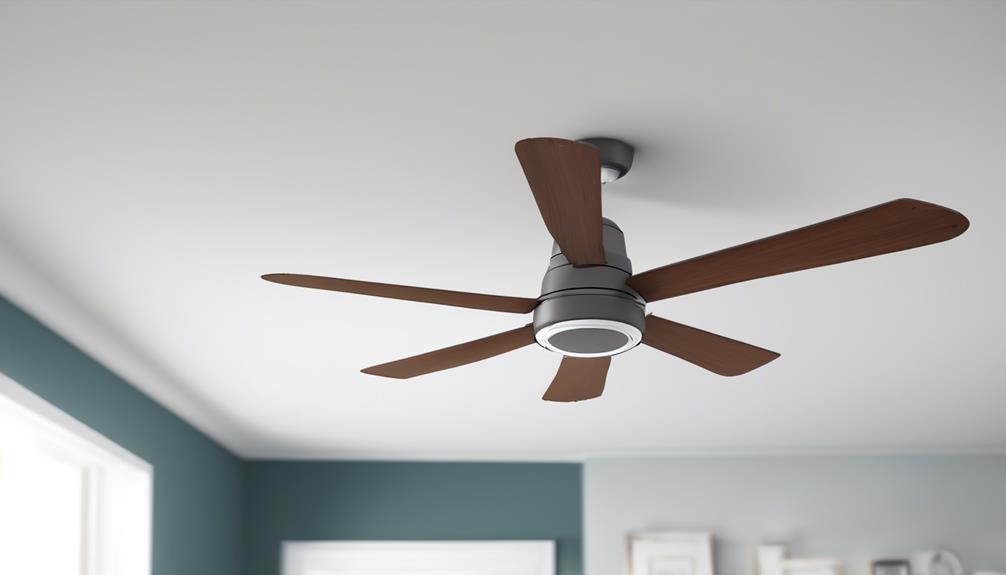
When choosing a ceiling fan based on airflow efficiency, there are several factors that need to be taken into consideration. These factors won't only affect the fan's performance but also its ability to effectively control room temperature and minimize energy consumption. Here are three key factors to consider:
- Blade Design: The design of the fan blades plays a crucial role in airflow efficiency. Opt for fan blades that are aerodynamically designed to move air effectively and quietly. Look for blades with a steeper pitch angle, as this allows for better air circulation and increased airflow.
- Motor Power: The motor is the heart of the ceiling fan and determines its performance. Choose a fan with a powerful motor that can effectively move air throughout the room. A high-quality motor ensures better airflow efficiency and helps maintain a comfortable room temperature.
- Energy Consumption Analysis: Consider the energy efficiency of the fan. Look for models that are ENERGY STAR certified, as they're designed to consume less energy while delivering optimal performance. Energy-efficient ceiling fans not only help you save on electricity bills but also reduce your carbon footprint.
How Does Ceiling Fan Airflow Efficiency Compare to Energy-Saving Air Fryers?
Ceiling fans, while distributing air effectively throughout a room, operate on a fundamentally different efficiency spectrum compared to energysaving compact air fryers. The latter, designed to cook food rapidly with minimal energy, utilizes targeted hot air technology, showcasing a leap in energy efficiency over the broad circulation approach of fans.
Frequently Asked Questions
How Does the Size of the Room Affect the Airflow Efficiency of a Ceiling Fan?
When considering the effectiveness of a ceiling fan's airflow, the size of the room plays a crucial role. Larger rooms require fans with a higher airflow efficiency to effectively circulate air. This is because a larger space requires a greater volume of air movement to achieve optimal comfort.
In contrast, smaller rooms can benefit from fans with lower airflow efficiencies, as they require less air circulation. Therefore, understanding the size of the room is essential in determining the appropriate airflow efficiency for a ceiling fan.
Can the Airflow Efficiency of a Ceiling Fan Be Improved Through Regular Maintenance?
Regular maintenance is key to improving airflow efficiency in ceiling fans. By performing simple maintenance techniques such as cleaning the blades, lubricating the motor, and checking for any loose screws or parts, you can ensure that your ceiling fan operates at its optimal level.
These maintenance tasks help to prevent dust and debris buildup, reduce friction, and maintain proper balance, resulting in increased airflow efficiency. Therefore, regular maintenance is crucial for maximizing the performance of your ceiling fan.
What Is the Ideal Blade Pitch for Maximizing Airflow Efficiency?
To maximize airflow efficiency, the ideal blade pitch for a ceiling fan depends on factors such as blade material and motor power. By adjusting the angle of the blades, you can optimize the fan's performance.
Blade pitch is typically measured in degrees and refers to the angle of the blades in relation to the horizontal plane. A steeper blade pitch can generate more airflow, but it may also require a more powerful motor to maintain optimal performance.
Are There Any Additional Factors, Apart From Blade Pitch, That Affect the Airflow Efficiency of a Ceiling Fan?
When considering the airflow efficiency of a ceiling fan, it's important to take into account various factors beyond just blade pitch.
Ceiling fan technology has evolved to include features such as fan speed control, which can greatly impact airflow efficiency. By adjusting the fan speed, you can optimize the airflow for different preferences and conditions.
It's crucial to understand the impact of fan speed on airflow efficiency in order to maximize the effectiveness of your ceiling fan.
How Does the Airflow Efficiency of a Ceiling Fan Impact Its Noise Levels?
The airflow efficiency of a ceiling fan has a direct impact on its noise levels. Specifically, factors such as ceiling height and blade design play a crucial role in determining the noise produced by the fan.
When a fan is highly efficient in terms of airflow, it can effectively move air without creating excessive noise.
On the other hand, if the airflow efficiency is compromised due to poor blade design or ceiling height, it can result in increased noise levels.
Conclusion
In conclusion, understanding and maximizing airflow efficiency in your ceiling fan is crucial for optimal comfort and energy savings. By considering factors such as blade pitch, room size, and noise levels, you can choose a fan that meets your specific needs.
Comparing different models and their airflow efficiency ratings will help you make an informed decision. So, don't settle for mediocre airflow performance; choose a ceiling fan that delivers efficient and effective air circulation for a more comfortable living space.
- About the Author
- Latest Posts
Introducing Ron, the home decor aficionado at ByRetreat, whose passion for creating beautiful and inviting spaces is at the heart of his work. With his deep knowledge of home decor and his innate sense of style, Ron brings a wealth of expertise and a keen eye for detail to the ByRetreat team.
Ron’s love for home decor goes beyond aesthetics; he understands that our surroundings play a significant role in our overall well-being and productivity. With this in mind, Ron is dedicated to transforming remote workspaces into havens of comfort, functionality, and beauty.
Appliances
3 Essential Tips for RV-Friendly Portable Washers

- Pros and cons of using eco friendly laundry detergent in a portable washer.
- Tips for preventing detergent residue buildup in a portable washer
Are you exhausted from constantly looking for laundromats during your RV trips? We get it. That’s why we’re here to provide three key tips for RV-friendly portable washing machines.
While you might be thinking, ‘Do I really need a portable washer?’ trust us, having one on your RV can be a game-changer. In this guide, we’ll show you how to choose the right size washer that fits your RV’s limited space, understand the power and water requirements to ensure smooth operation, and provide you with maintenance and cleaning tips to keep your washer running efficiently.
So, let’s dive in and master the art of laundry on the road!
Key Takeaways
- Consider the laundry capacity needed for your RV.
- Look for compact and lightweight options with space-saving features.
- Choose a portable washer with high energy efficiency and water conservation features.
- Regularly maintain and clean your portable washer using recommended cleaning products.
Choosing the Right Size
One of the first considerations when selecting a portable washer for our RV is determining the appropriate size. Portable washer features and space-saving options play a crucial role in making this decision. When it comes to size, it’s important to find a washer that fits well within the limited space of an RV, while still providing enough capacity to meet our laundry needs.
To begin with, portable washers come in a range of sizes, typically measured in pounds of laundry capacity. It’s essential to consider the amount of laundry we anticipate doing on a regular basis. While a smaller capacity may be suitable for individuals or couples, larger families might require a washer with a higher capacity to accommodate their laundry demands.
Additionally, it’s important to consider the physical dimensions of the washer. RVs have limited space, so opting for a compact and lightweight washer can help maximize the available room. Some portable washers are designed with space-saving features such as folding handles, detachable components, or even stackable options that can fit neatly into tight spaces.
Understanding Power and Water Requirements
When considering the power and water requirements for our RV-friendly portable washer, we need to understand the necessary resources for optimal performance.
Energy efficiency is an important factor to consider when choosing a portable washer for your RV. Look for models that have a high Energy Star rating, as this indicates that they consume less energy and can help you save on your electricity bills.

Additionally, portable washer features such as load sensing technology and adjustable water levels can help you conserve water. These features ensure that the washer only uses the amount of water necessary to clean your laundry, which is particularly crucial when you have limited water supply in your RV.
It’s also important to check the power requirements of the portable washer. Make sure that the washer is compatible with the power source available in your RV, whether it’s a standard 120-volt outlet or a 12-volt DC power source.
Understanding the power and water requirements of your RV-friendly portable washer won’t only help you achieve optimal performance but also contribute to energy and water conservation.
Maintenance and Cleaning Tips
Let’s talk about how to properly maintain and clean your RV-friendly portable washer. Taking care of your portable washer is essential to ensure its longevity and optimal performance. Regular maintenance and cleaning will help prevent any potential issues and keep your machine running smoothly. Here are some common troubleshooting tips and recommended cleaning products to keep in mind:
| Common Troubleshooting | Recommended Cleaning Products |
|---|---|
| Leaking water | Vinegar and water mixture |
| Excessive noise | Mild detergent |
| Drum not spinning | Baking soda |
| Error codes | Citric acid |
If you encounter a problem such as leaking water, try using a mixture of vinegar and water to clean the machine’s seals and hoses. For excessive noise, use a mild detergent to clean the drum and remove any debris that may be causing the noise. If the drum is not spinning, try using baking soda to remove any buildup that may be hindering its movement. Lastly, if you receive error codes, using citric acid in the detergent compartment can help clean the sensors and resolve the issue.
Remember to always refer to your portable washer’s manual for specific maintenance instructions and troubleshooting tips. By following these guidelines and using the recommended cleaning products, you can keep your RV-friendly portable washer in great condition and enjoy clean laundry on your travels.
Frequently Asked Questions
How Long Does It Typically Take to Wash a Full Load of Laundry Using a Portable Washer?
Typically, it takes around 30 to 45 minutes to wash a full load of laundry using a portable washer.
However, it’s important to consider the capacity limitations of these machines. Most portable washers have a smaller capacity compared to traditional washers, so it may take longer if you have a larger load.
It’s always a good idea to follow the manufacturer’s instructions and not overload the machine to ensure efficient and effective washing.
Can I Use Regular Laundry Detergent in a Portable Washer, or Do I Need to Use a Specific Type?
Yes, you can use regular laundry detergent in a portable washer. However, there are some pros and cons to consider.
Using eco-friendly laundry detergent in a portable washer is a great option for those who want to reduce their environmental footprint. It can be gentler on your clothes and safer for the environment.
However, some eco-friendly detergents may not be as effective at removing tough stains. To prevent detergent residue buildup, make sure to use the recommended amount of detergent and run an extra rinse cycle if needed.
Is It Safe to Leave a Portable Washer Unattended While It’s Running?
Safety precautions should be taken when using a portable washer unattended. There are potential risks involved, such as water leakage or electrical malfunctions. It’s important to follow the manufacturer’s instructions and guidelines for safe operation.
Some tips to minimize risks include ensuring a stable surface, avoiding overloading the machine, and regularly checking for any signs of damage.
It’s always best to err on the side of caution when it comes to leaving a portable washer running without supervision.
Can I Wash Delicate Fabrics, Such as Silk or Lace, in a Portable Washer?
When it comes to washing delicate fabrics like silk or lace in a portable washer, there are a few things to keep in mind.
Firstly, check the manufacturer’s instructions to ensure that your specific model is suitable for these types of fabrics.
Secondly, use a gentle cycle and cold water to minimize any potential damage.
Lastly, consider placing delicate items in a mesh laundry bag for added protection.
With these precautions, you can safely wash your delicate fabrics in an RV-friendly portable washer.

How Noisy Are Portable Washers When in Operation?
When it comes to the noise level of portable washers, it’s important to consider their energy efficiency as well. These machines are designed to be compact and efficient, so they tend to operate quietly. While they do make some noise during operation, it’s typically minimal and shouldn’t disturb your RV neighbors or disrupt your peaceful campsite.
Plus, their energy efficiency means you can enjoy clean clothes without draining your RV’s power supply.
Conclusion
In conclusion, choosing the right size portable washer for your RV, understanding power and water requirements, and following maintenance and cleaning tips are essential for a smooth laundry experience on the road.
By coincidence, we stumbled upon a fellow traveler at a campsite who’d just purchased a portable washer based on our article. They were thrilled with the convenience and efficiency it provided.
So, take these tips into consideration and enjoy clean clothes wherever your adventures take you!
- About the Author
- Latest Posts
Introducing Charles, the Editor in Chief at ByRetreat, whose passion for interior design and editorial excellence elevates every remote workspace to new heights. With his keen eye for detail, impeccable taste, and expertise in design, Charles brings a wealth of knowledge and creativity to the ByRetreat team.
As the Editor in Chief of a renowned lifestyle blog, Charles has honed his skills in curating captivating content and staying up-to-date with the latest trends in interior design. His deep understanding of aesthetics and the power of storytelling through design enables him to create remote workspaces that are not only visually stunning but also rich in personality and meaning.
Appliances
4 Smart Tips for Extended Commercial Appliance Warranties

Did you realize that nearly 80% of commercial appliance malfunctions happen after the manufacturer’s warranty runs out? As business operators, we grasp the significance of safeguarding our assets and reducing unforeseen costs.
That’s why we have compiled four smart tips for extended commercial appliance warranties that will help you make informed decisions and ensure the longevity of your appliances.
In this guide, we will discuss choosing the right warranty provider, understanding coverage and exclusions, evaluating the cost and value, and maximizing the benefits of extended warranties.
By following these tips, you can have peace of mind knowing that your appliances are protected and your business operations can continue smoothly.
Let’s dive in and master the art of extended warranties!
Key Takeaways
- Choose a warranty provider with a good reputation and track record.
- Understand the coverage details and limitations of the warranty.
- Evaluate the cost and value of extended warranties.
- Maximize the benefits by understanding the claim process and maintaining your appliances.
Choosing the Right Warranty Provider
When selecting a warranty provider for extended commercial appliance warranties, we should consider their reputation and track record in the industry. Identifying reputable providers is crucial to ensure that we’re dealing with a company that has a history of delivering on their promises and providing excellent service to their customers. A reputable provider will have a strong presence in the market and positive reviews from satisfied clients. They’ll also have a proven track record of handling warranty claims efficiently and resolving issues promptly.
In addition to reputation, it’s important to compare warranty terms offered by different providers. We should carefully review the terms and conditions of each warranty to ensure that they meet our specific needs and requirements. This includes understanding the coverage provided, such as if it includes parts and labor costs, and the duration of the warranty. It’s also important to consider any limitations or exclusions that may apply.
Understanding Coverage and Exclusions
To fully understand the extent of coverage and any exclusions, we should carefully review the warranty terms and conditions for our extended commercial appliance warranties. Many people have common misconceptions about what’s covered under these warranties, which is why it’s so important to read the fine print. Here are some key points to consider:
- Scope of coverage: It’s crucial to understand what types of repairs or replacements are included in the warranty. This may vary depending on the provider and the specific appliance being covered. Some warranties may only cover certain parts or components, while others may offer more comprehensive coverage.
- Exclusions: Even though warranties provide coverage, there are often exclusions stated in the terms and conditions. These exclusions may include damage caused by misuse, neglect, or unauthorized repairs. It’s important to be aware of these exclusions to avoid any surprises when filing a claim.
- Duration of coverage: Extended commercial appliance warranties can vary in terms of their duration. Some warranties may provide coverage for a fixed period of time, while others may offer coverage until a certain number of repairs or replacements have been made. Understanding the duration of coverage can help us plan for future maintenance and repairs.
- Claim process: Familiarizing ourselves with the claim process is essential. This includes knowing who to contact, what documentation is required, and any specific procedures that need to be followed to ensure a smooth and efficient claim experience.
Evaluating the Cost and Value
To determine the cost-effectiveness of extended commercial appliance warranties, we need to assess their overall value. When weighing options and considering budget considerations, it is essential to evaluate the benefits and drawbacks of purchasing extended warranties for your appliances. To help you make an informed decision, we have created a table that outlines the key factors to consider:
| Factors to Consider | Benefits | Drawbacks |
|---|---|---|
| Coverage | Extended protection beyond the manufacturer’s warranty period | Additional cost |
| Repair Costs | Potential savings on repair expenses | Warranty cost may outweigh repair costs |
| Peace of Mind | Assurance that your appliances are protected | Limited likelihood of appliance failure |
By considering these factors, you can determine whether the cost of an extended warranty is justified by its value. It is important to note that budget considerations should not be the sole determining factor. While extended warranties may come at an additional cost, they can provide peace of mind and potential savings on repair expenses.
In the next section, we will explore strategies for maximizing the benefits of extended warranties, ensuring that you get the most value out of your investment.
Maximizing the Benefits of Extended Warranties
To maximize the benefits of extended warranties, we can employ strategies that optimize our investment. By understanding the claim process and exploring renewal options, we can ensure that our commercial appliance warranties provide us with the maximum value and protection.
Here are some smart tips for maximizing the benefits of extended warranties:
- Thoroughly understand the claim process: Familiarize yourself with the steps involved in filing a claim. Know the required documentation, such as proof of purchase and warranty information. By being prepared, you can expedite the claim process and minimize downtime.
- Regularly maintain your appliances: Proper maintenance is crucial for the longevity and performance of your commercial appliances. Follow the manufacturer’s guidelines for cleaning, servicing, and inspections. Regular maintenance not only extends the lifespan of your appliances but also helps prevent potential issues that may require warranty claims.
- Research renewal options: When your extended warranty is about to expire, explore renewal options offered by the warranty provider. Some providers offer extended renewal plans with additional coverage, giving you continued peace of mind and protection for your investment.
- Keep warranty documents organized: Maintain a dedicated folder or digital file for all your warranty documents. This ensures easy access to necessary information when filing a claim or renewing your warranty.
Frequently Asked Questions
How Can I Extend the Warranty on My Commercial Appliance if It’s Already Expired?
To extend the warranty on your commercial appliance after it has expired, there are several renewal options available.
You can contact the manufacturer or a third-party warranty provider to inquire about their extended warranty programs. They may offer coverage plans specifically designed for appliances with expired warranty coverage.
It’s important to carefully review the terms and conditions, as well as the cost, of these extended warranty options to ensure they meet your needs and budget.
Are There Any Specific Requirements or Limitations for Obtaining an Extended Warranty for Commercial Appliances?
When obtaining an extended warranty for commercial appliances, it’s important to be aware of the common exclusions in extended warranty coverage. These may include wear and tear, cosmetic damage, and misuse or negligence.
To choose the right extended warranty, consider factors such as the length of coverage, cost, and reputation of the provider.
It’s also crucial to thoroughly read and understand the terms and conditions of the warranty to avoid any surprises down the line.
Can I Transfer My Extended Warranty to a New Owner if I Sell My Commercial Appliance?
Yes, you can transfer your extended warranty to a new owner if you sell your commercial appliance. This ensures that the warranty coverage for used appliances continues with the new owner.
It’s important to check the specific requirements and limitations of your extended warranty to ensure a smooth transfer process. By transferring the warranty, you provide peace of mind to the new owner and protect them against any unexpected repair or replacement costs.
What Happens if My Commercial Appliance Breaks Down Multiple Times During the Extended Warranty Period?
If your commercial appliance breaks down multiple times during the extended warranty period, you may be eligible for claim reimbursement. The repair or replacement timeline will depend on the terms and conditions of your warranty.
It’s important to thoroughly review the warranty agreement to understand the process and any limitations. Our team is here to help ensure that your claims are handled efficiently and that you receive the necessary repairs or replacements in a timely manner.
Is There a Limit to the Number of Claims I Can Make Under an Extended Warranty for My Commercial Appliance?
There are limitations to the number of claims we can make under an extended warranty for our commercial appliance.
However, it’s important to note that extended warranties offer numerous benefits for commercial appliances. They provide peace of mind by covering repairs and replacements, reducing downtime and maintenance costs.
Conclusion
In conclusion, when it comes to extended commercial appliance warranties, there are several crucial considerations to keep in mind.
Firstly, choosing the right provider is essential. It’s important to research and compare different warranty providers to ensure they have a good reputation and offer comprehensive coverage.
Understanding coverage and exclusions is also crucial. Businesses should carefully review the terms and conditions of the warranty to know exactly what is covered and what is not. This will help avoid any surprises or disappointments down the line.

Evaluating cost and value is another important factor. Businesses should consider the cost of the warranty in relation to the potential repair or replacement costs of the appliances. They should also assess the value of the warranty by considering additional benefits such as extended service hours or priority service.
Lastly, maximizing benefits is key. Businesses should take advantage of all the benefits offered by the warranty, such as regular maintenance or discounted repairs. This will help ensure the appliances are well-maintained and any issues are addressed promptly.
By following these smart tips, businesses can make informed decisions that protect their investments. Just like a well-oiled machine, a well-chosen warranty can provide peace of mind and keep the business running smoothly. So don’t leave your appliances vulnerable, take action and secure their longevity today.
- About the Author
- Latest Posts
Introducing Charles, the Editor in Chief at ByRetreat, whose passion for interior design and editorial excellence elevates every remote workspace to new heights. With his keen eye for detail, impeccable taste, and expertise in design, Charles brings a wealth of knowledge and creativity to the ByRetreat team.
As the Editor in Chief of a renowned lifestyle blog, Charles has honed his skills in curating captivating content and staying up-to-date with the latest trends in interior design. His deep understanding of aesthetics and the power of storytelling through design enables him to create remote workspaces that are not only visually stunning but also rich in personality and meaning.
Appliances
3 Essential DIY HVAC Maintenance Tips Unveiled

Ah, the pleasures of tending to our HVAC systems! We understand the excitement of dedicating our valuable time to the upkeep and repair of these marvelous devices. But do not worry, dear reader, as we have revealed the tips to becoming skilled at DIY HVAC maintenance.
In this guide, we will unveil three essential tips that will ensure your HVAC system remains in perfect harmony. Get ready to dive into the world of air filters, thermostat settings, and outdoor condenser units. We will show you how to clean, check, and clear with ease, all while achieving that coveted mastery over your HVAC system.
So, let’s roll up our sleeves and get down to business, shall we?
Key Takeaways
- Regular maintenance, including cleaning air filters and checking thermostat settings, is essential for optimal HVAC system performance.
- Cleaning or replacing air filters prevents clogging and maintains a healthy indoor environment.
- Checking and maintaining thermostat settings ensures accurate temperature control and programming.
- Clearing debris from the outdoor condenser unit improves its performance and prevents airflow restriction.
Cleaning Air Filters Regularly
We recommend cleaning air filters regularly to ensure proper airflow and maintain optimal HVAC system performance. Replacing air filters is a crucial part of HVAC maintenance that often gets overlooked.
Air filters play a significant role in improving indoor air quality by capturing dust, pollen, and other airborne particles. Over time, these particles can accumulate on the filters, causing them to become clogged and obstructing the airflow. This can result in reduced efficiency and increased energy consumption.
By cleaning or replacing air filters on a regular basis, you can prevent these issues and maintain a healthy indoor environment.
Cleaning air filters is a relatively simple task that can be done by the homeowner. Start by turning off the HVAC system and locating the air filter. Remove the filter and inspect it for any visible dirt or debris. If the filter is washable, gently clean it with water and a mild detergent. Allow it to dry thoroughly before reinstalling. If the filter isn’t washable, it should be replaced with a new one. Remember to check the manufacturer’s recommendations for the appropriate filter type and replacement schedule.
Checking and Maintaining Thermostat Settings
To ensure optimal HVAC system performance, it’s important to regularly check and maintain the thermostat settings. The thermostat acts as the control center for your heating and cooling system, allowing you to adjust the temperature and program a schedule that suits your needs.
Start by adjusting the temperature settings to the desired level. This can be done manually or through programming. If you prefer a consistent temperature throughout the day, programming a schedule can help save energy and maintain comfort. Make sure to set different temperatures for when you’re away from home or asleep.
Regularly check the accuracy of your thermostat by comparing it to a separate thermometer. If there’s a discrepancy, recalibrate the thermostat to ensure accurate readings.
Keep the thermostat clean and free from dust and debris. Use a soft cloth to wipe away any buildup that may affect its functionality.
Lastly, check the batteries in your thermostat. Dead or low batteries can cause the thermostat to malfunction. Replace them as needed to ensure proper operation.
Clearing Debris From Outdoor Condenser Unit
Clearing debris from the outdoor condenser unit involves removing any dirt, leaves, and other obstructions that can hinder its performance. It’s important to regularly inspect and clean the condenser coil to ensure optimal functioning of the HVAC system.
To begin, it’s crucial to remove any vegetation that may have grown around the outdoor condenser unit. Plants, shrubs, or trees that are too close to the unit can restrict airflow and reduce its efficiency. Cut back any overhanging branches or foliage that may block the airflow and impede the unit’s ability to cool the air effectively.
Next, inspect the condenser coil for any debris buildup. Over time, dirt, leaves, and other particles can accumulate on the coil, obstructing the airflow and reducing its heat transfer capabilities. Gently brush away any debris using a soft-bristle brush or a vacuum cleaner with a brush attachment. Be careful not to damage the delicate fins of the coil during the cleaning process.
In addition to removing debris, it’s essential to inspect the coil for any signs of damage or corrosion. If any bent fins are detected, use a fin comb to straighten them out carefully. If there’s significant damage or corrosion, it’s recommended to contact a professional HVAC technician for further assessment and repair.
Regularly clearing debris and maintaining the condenser coil will help ensure that the outdoor unit operates efficiently and prolong its lifespan. By following these simple steps, you can optimize the performance of your HVAC system and maintain a comfortable indoor environment.
Frequently Asked Questions
How Often Should I Clean or Replace My Air Filters?
To improve the air quality in our homes, it’s essential to clean or replace air filters regularly. So, how often should we clean or replace them?
It’s recommended to clean or replace air filters every 1 to 3 months, depending on factors like the type of filter, the level of pollutants, and the frequency of HVAC system usage. Regular maintenance ensures that the air flowing through our HVAC system is clean and healthy, promoting a comfortable and safe living environment.
Can I Use Any Type of Air Filter for My HVAC System?
Can we use any type of air filter for our HVAC system?

It’s important to understand that not all air filters are created equal. There are different types of air filters available in the market, each with its own specifications and benefits.
Using the right filter for your HVAC system is crucial in ensuring optimal performance and indoor air quality. It’s recommended to consult with a professional to determine the best filter for your specific system and needs.
Are There Any Specific Thermostat Settings I Should Be Aware of During Different Seasons?
During different seasons, it’s important to adjust thermostat programming to maximize energy efficiency. By setting higher temperatures in the summer and lower temperatures in the winter, you can reduce the workload on your HVAC system and save on energy costs.
Additionally, utilizing programmable thermostats can help automate these adjustments, ensuring optimal comfort and efficiency.
How Can I Determine if the Outdoor Condenser Unit Is Blocked by Debris?
To determine if the outdoor condenser unit is blocked by debris, we can look for certain signs.
One key indicator is reduced airflow coming from the unit. If you notice that the air isn’t flowing as strongly as before, it could be a sign of blockage.
Another sign to watch out for is unusual noises coming from the condenser, which could indicate damage.
Regularly inspecting and cleaning the unit will help prevent any potential issues and ensure optimal performance.
What Are the Potential Consequences of Not Regularly Cleaning the Air Filters or Clearing Debris From the Outdoor Condenser Unit?
Neglecting HVAC maintenance can lead to serious consequences. Regularly cleaning air filters and clearing debris from the outdoor condenser unit is of utmost importance. Failure to do so can result in reduced airflow, decreased efficiency, and higher energy bills.
Additionally, dirty filters can lead to poor indoor air quality and potential health issues. By prioritizing regular HVAC maintenance, we ensure optimal performance, extend the lifespan of our system, and create a healthier and more comfortable living environment.
Conclusion
In conclusion, by regularly cleaning air filters, checking and maintaining thermostat settings, and clearing debris from the outdoor condenser unit, homeowners can ensure optimal performance and efficiency of their HVAC systems.
These essential DIY maintenance tips not only extend the lifespan of the system but also improve indoor air quality and reduce energy consumption.
By taking these simple steps, homeowners can enjoy a comfortable and healthy living environment while saving on utility bills.
- About the Author
- Latest Posts
Introducing Charles, the Editor in Chief at ByRetreat, whose passion for interior design and editorial excellence elevates every remote workspace to new heights. With his keen eye for detail, impeccable taste, and expertise in design, Charles brings a wealth of knowledge and creativity to the ByRetreat team.
As the Editor in Chief of a renowned lifestyle blog, Charles has honed his skills in curating captivating content and staying up-to-date with the latest trends in interior design. His deep understanding of aesthetics and the power of storytelling through design enables him to create remote workspaces that are not only visually stunning but also rich in personality and meaning.
-

 Vetted2 days ago
Vetted2 days ago15 Best Folding Beds for Small Spaces – Space-Saving Solutions for Comfort and Convenience
-

 Vetted22 hours ago
Vetted22 hours ago15 Best Waterproof Flooring Options for Your Bathroom – Ultimate Guide & Reviews
-

 Vetted6 days ago
Vetted6 days ago15 Best Grocery Carts to Make Shopping a Breeze
-

 Vetted2 weeks ago
Vetted2 weeks ago15 Best Gravel for Driveway: The Ultimate Guide for a Durable and Stunning Entrance
-

 Vetted4 days ago
Vetted4 days ago15 Best Steam Generators for Showering Bliss: Reviewed & Rated
-

 Beginners Guides3 weeks ago
Beginners Guides3 weeks agoI Inhaled Vinegar Fumes
-

 Vetted2 weeks ago
Vetted2 weeks ago15 Best Hot Tubs of 2024: Luxurious Relaxation at Your Fingertips
-

 Vetted4 weeks ago
Vetted4 weeks ago15 Best Blinds for Bathroom Windows to Enhance Privacy and Style


















